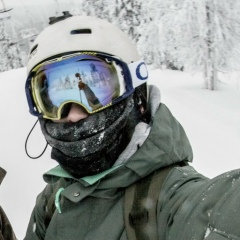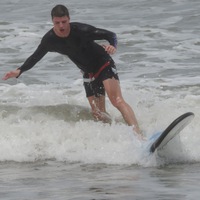Дзен-уроки от природы
Первый урок, как ни странно, от дятла: «Урок реалистичной фокусировки».
Дятел во многом умнее нас. Да, он бьется головой о дерево, но делает это он очень успешно. Он реалистичен — он не пытается разбить дерево пополам одним ударом, как это хотят сделать многие из нас, и он сфокусирован — он не стучит в дерево со всех сторон. Он фокусировано бьет в одну и ту же точку, медленно продвигаясь к своему червячку. Нам же нужен не червяк, а сразу змей, и найти его мы хотим не в плотном дереве, а лишь присыпанным листьями на земле.
Второй урок — от рыбы: «Урок потока».
Рыба всегда плывет против течения и, вопреки общему мнению, это правильно. Она это делает не для того, чтобы усложнить себе жизнь, а для того, чтобы больше воды мимо себя пропустить. Так мимо нее в потоке воды проплывает больше еды и кислорода. Так ее жизнь становится в несколько раз богаче. Мы же, в отличие от рыбы, всегда пытаемся плыть по течению в стагнирующем потоке, и в результате вместо 30 лет жизненного опыта, мы наживаем однолетний жизненный опыт 30 раз. Мы не хотим выходить из комфортной зоны и потом удивляемся, почему в жизни было так мало возможностей. Мы хотим выиграть лотерею жизни, даже не покупая лотерейного билета.
Третий урок — от маленьких львят: «Запачкай морду кровью».
Маленькие львята умеют учиться. Они учатся у старших, более опытных, львов. И учатся они не по учебникам и разговорам, а на деле. Они точно знают — чтобы научиться охотиться, нужно запачкать морду кровью. Мы же боимся даже руки замарать. Мы садимся за парты и смотрим на стоящего у доски зайца, который учит нас охотиться. Или закрываемся дома и учимся сами, а когда приходит время охоты, мы не то что охотиться не умеем, мы боимся даже запаха крови.
Четвертый урок (социальный) — от собаки: «Повиляй хвостом первый».
В 21 веке уже не важно, что делаешь ты, а важно, на что ты мотивируешь других людей. И прекрасный пример дает собака. Собака не думает: «Сначала ты меня домой приведи, накорми и помой, а потом я тебе повиляю хвостом.» Собака первая отдает свои чувства и лишь потом получает взамен то, что ей нужно. При этом она не заставляет вас ей ничего отдавать, она делает так, что вы сами хотите это сделать.
Пятый урок — от змеи: «Не ной».
Змея не думает: «У меня нет ни рук, ни ног, у меня плохое зрение, я родилась не в той стране, меня никто не любит, мои родители обо мне не заботились с момента как я вылупилась». Змея обходится тем, что у нее есть, и мы даже боимся этого «животного-инвалида». И если ей что-то не нравится, она просто меняет шкуру и ползет дальше без сожалений.
Первый урок, как ни странно, от дятла: «Урок реалистичной фокусировки».
Дятел во многом умнее нас. Да, он бьется головой о дерево, но делает это он очень успешно. Он реалистичен — он не пытается разбить дерево пополам одним ударом, как это хотят сделать многие из нас, и он сфокусирован — он не стучит в дерево со всех сторон. Он фокусировано бьет в одну и ту же точку, медленно продвигаясь к своему червячку. Нам же нужен не червяк, а сразу змей, и найти его мы хотим не в плотном дереве, а лишь присыпанным листьями на земле.
Второй урок — от рыбы: «Урок потока».
Рыба всегда плывет против течения и, вопреки общему мнению, это правильно. Она это делает не для того, чтобы усложнить себе жизнь, а для того, чтобы больше воды мимо себя пропустить. Так мимо нее в потоке воды проплывает больше еды и кислорода. Так ее жизнь становится в несколько раз богаче. Мы же, в отличие от рыбы, всегда пытаемся плыть по течению в стагнирующем потоке, и в результате вместо 30 лет жизненного опыта, мы наживаем однолетний жизненный опыт 30 раз. Мы не хотим выходить из комфортной зоны и потом удивляемся, почему в жизни было так мало возможностей. Мы хотим выиграть лотерею жизни, даже не покупая лотерейного билета.
Третий урок — от маленьких львят: «Запачкай морду кровью».
Маленькие львята умеют учиться. Они учатся у старших, более опытных, львов. И учатся они не по учебникам и разговорам, а на деле. Они точно знают — чтобы научиться охотиться, нужно запачкать морду кровью. Мы же боимся даже руки замарать. Мы садимся за парты и смотрим на стоящего у доски зайца, который учит нас охотиться. Или закрываемся дома и учимся сами, а когда приходит время охоты, мы не то что охотиться не умеем, мы боимся даже запаха крови.
Четвертый урок (социальный) — от собаки: «Повиляй хвостом первый».
В 21 веке уже не важно, что делаешь ты, а важно, на что ты мотивируешь других людей. И прекрасный пример дает собака. Собака не думает: «Сначала ты меня домой приведи, накорми и помой, а потом я тебе повиляю хвостом.» Собака первая отдает свои чувства и лишь потом получает взамен то, что ей нужно. При этом она не заставляет вас ей ничего отдавать, она делает так, что вы сами хотите это сделать.
Пятый урок — от змеи: «Не ной».
Змея не думает: «У меня нет ни рук, ни ног, у меня плохое зрение, я родилась не в той стране, меня никто не любит, мои родители обо мне не заботились с момента как я вылупилась». Змея обходится тем, что у нее есть, и мы даже боимся этого «животного-инвалида». И если ей что-то не нравится, она просто меняет шкуру и ползет дальше без сожалений.
Zen lessons from nature
The first lesson, oddly enough, is from a woodpecker: "A lesson in realistic focusing."
Woodpecker is much smarter than us. Yes, he bangs his head against a tree, but he does it very successfully. He is realistic - he does not try to split the tree in half with one blow, as many of us want to do, and he is focused - he does not knock on the tree from all sides. He focuses on one and the same point, slowly moving towards his worm. We do not need a worm, but a snake right away, and we do not want to find it in a dense tree, but only with dusted leaves on the ground.
The second lesson is from fish: "The lesson of the stream."
The fish always swims against the tide and, contrary to the general opinion, this is correct. She does this not in order to complicate her life, but in order to let more water pass by herself. So past her in a stream of water floats more food and oxygen. So her life becomes several times richer. We, unlike fish, always try to go with the flow in a stagnant stream, and as a result, instead of 30 years of life experience, we gain one-year life experience 30 times. We do not want to leave the comfort zone and then wonder why there were so few opportunities in life. We want to win the lottery of life without even buying a lottery ticket.
The third lesson is from little cubs: “Stain your face with blood.”
Little lion cubs can learn. They learn from older, more experienced lions. And they learn not from textbooks and conversations, but in practice. They know for sure - in order to learn how to hunt, you need to stain your face with blood. We are afraid even to mess our hands. We sit at the desks and look at the hare standing by the board, who teaches us to hunt. Or we close ourselves at home and study ourselves, and when the time comes for hunting, we don’t know how to hunt, we are afraid of even the smell of blood.
The fourth lesson (social) is from the dog: “Wag your tail first.”
In the 21st century, it doesn’t matter what you do, but what you motivate other people on is important. And a great example is the dog. The dog does not think: “First you bring me home, feed and wash, and then I wag your tail.” The dog first gives its feelings and only then receives in return what it needs. At the same time, she does not force you to give her anything, she makes it so that you yourself want to do it.
The fifth lesson is from the snake: "Do not whine."
The snake does not think: "I have neither arms nor legs, I have poor eyesight, I was born in the wrong country, nobody loves me, my parents did not care about me from the moment I hatched." The snake manages what it has, and we are even afraid of this "animal with a disability." And if she doesn’t like something, she just changes her skin and crawls on without regrets.
The first lesson, oddly enough, is from a woodpecker: "A lesson in realistic focusing."
Woodpecker is much smarter than us. Yes, he bangs his head against a tree, but he does it very successfully. He is realistic - he does not try to split the tree in half with one blow, as many of us want to do, and he is focused - he does not knock on the tree from all sides. He focuses on one and the same point, slowly moving towards his worm. We do not need a worm, but a snake right away, and we do not want to find it in a dense tree, but only with dusted leaves on the ground.
The second lesson is from fish: "The lesson of the stream."
The fish always swims against the tide and, contrary to the general opinion, this is correct. She does this not in order to complicate her life, but in order to let more water pass by herself. So past her in a stream of water floats more food and oxygen. So her life becomes several times richer. We, unlike fish, always try to go with the flow in a stagnant stream, and as a result, instead of 30 years of life experience, we gain one-year life experience 30 times. We do not want to leave the comfort zone and then wonder why there were so few opportunities in life. We want to win the lottery of life without even buying a lottery ticket.
The third lesson is from little cubs: “Stain your face with blood.”
Little lion cubs can learn. They learn from older, more experienced lions. And they learn not from textbooks and conversations, but in practice. They know for sure - in order to learn how to hunt, you need to stain your face with blood. We are afraid even to mess our hands. We sit at the desks and look at the hare standing by the board, who teaches us to hunt. Or we close ourselves at home and study ourselves, and when the time comes for hunting, we don’t know how to hunt, we are afraid of even the smell of blood.
The fourth lesson (social) is from the dog: “Wag your tail first.”
In the 21st century, it doesn’t matter what you do, but what you motivate other people on is important. And a great example is the dog. The dog does not think: “First you bring me home, feed and wash, and then I wag your tail.” The dog first gives its feelings and only then receives in return what it needs. At the same time, she does not force you to give her anything, she makes it so that you yourself want to do it.
The fifth lesson is from the snake: "Do not whine."
The snake does not think: "I have neither arms nor legs, I have poor eyesight, I was born in the wrong country, nobody loves me, my parents did not care about me from the moment I hatched." The snake manages what it has, and we are even afraid of this "animal with a disability." And if she doesn’t like something, she just changes her skin and crawls on without regrets.

У записи 16 лайков,
0 репостов,
1811 просмотров.
0 репостов,
1811 просмотров.
Эту запись оставил(а) на своей стене Ира Краснова





































